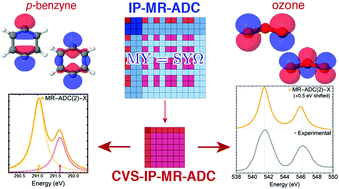Simulating X-ray photoelectron spectra with strong electron correlation using multireference algebraic diagrammatic construction theory†
Abstract
We present a new theoretical approach for the simulations of X-ray photoelectron spectra of strongly correlated molecular systems that combines multireference algebraic diagrammatic construction theory (MR-ADC) [J. Chem. Phys., 2018, 149, 204113] with a core–valence separation (CVS) technique. The resulting CVS-MR-ADC approach has a low computational cost while overcoming many challenges of the conventional multireference theories associated with the calculations of excitations from inner-shell and core molecular orbitals. Our results demonstrate that the CVS-MR-ADC methods are as accurate as single-reference ADC approximations for predicting core ionization energies of weakly-correlated molecules, but are more accurate and reliable for systems with a multireference character, such as a stretched nitrogen molecule, ozone, and isomers of the benzyne diradical. We also highlight the importance of multireference effects for the description of core–hole screening that determines the relative spacing and order of peaks in the XPS spectra of strongly correlated systems.

- This article is part of the themed collection: 2022 PCCP HOT Articles


 Please wait while we load your content...
Please wait while we load your content...
